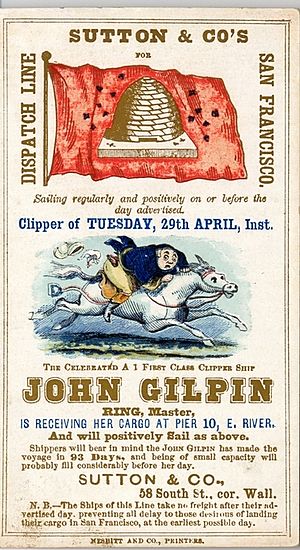John Gilpin (clipper) facts for kids
class="infobox " style="float: right; clear: right; width: 315px; border-spacing: 2px; text-align: left; font-size: 90%;"
| colspan="2" style="text-align: center; font-size: 90%; line-height: 1.5em;" | 
|}
The John Gilpin was a very fast sailing ship, called a clipper, built in 1852. It was named after a character from a famous poem. This ship was well-known for two main things: a thrilling race against another clipper called Flying Fish and a serious accident where it hit an iceberg.
Contents
- Setting Sail: The Start of the Race
- A Close Contest Across the Ocean
- The Finish Line: Who Won?
- The Role of Charts: A Smart Way to Sail
| History | |
|---|---|
| Name | John Gilpin |
| Owner | Pierce & Hunnewell, Boston |
| Builder | Samuel Hall, East Boston |
| Launched | September 1852 |
| Fate |
|
| Notes | Designed by Samuel Hall |
| General characteristics | |
| Class and type | Extreme clipper |
| Length | 195 ft. ; 205 ft. LOA |
| Beam | 37 ft. |
| Draft | 22 ft. |
| Notes | 2 decks |
Adventures at Sea: John Gilpin's Voyages
The John Gilpin traveled to many different places across the world's oceans. These long trips were called voyages. Clippers like the John Gilpin were designed to carry goods quickly, especially during the California Gold Rush.
Here are some of its important voyages:
- From New York to San Francisco: This trip took 114 days in 1854–55.
- Another trip from New York to San Francisco: This one took 133 days in 1855.
- From Manila to New York: This voyage was 111 days long in 1855.
- From New York to San Francisco: This journey took 139 days in 1856.
- From Honolulu to New Bedford: The ship carried whale oil and arrived in 117 days in 1857.
- From Boston to Honolulu: This trip took 116 days in 1857.
The Great Clipper Race: John Gilpin vs. Flying Fish
In 1852, the John Gilpin took part in an exciting race against other famous clippers. These races were like the "Derby of the sea," where ships competed to see who could reach San Francisco fastest from New York City.
Setting Sail: The Start of the Race
The John Gilpin left New York on October 29, 1852. Its captain was Justine Doane. Just a few days later, on November 1, the Flying Fish started its journey. Both ships were trying to be the fastest.
A Close Contest Across the Ocean
The race was incredibly close, lasting over 15,000 miles across the Atlantic and Pacific Oceans.
- The Flying Fish reached the equator first, 21 days from New York.
- The John Gilpin then sped up, taking the lead for a while.
- Near Cape Horn, the ships were almost side-by-side! The captain of the Flying Fish even joked about inviting the John Gilpin's captain for dinner.
- The Flying Fish pulled ahead again after Cape Horn.
The Finish Line: Who Won?
In the end, the Flying Fish won the race, arriving in San Francisco in 92 days and 4 hours. The John Gilpin was right behind it, finishing in 93 days and 20 hours. This difference of only 24 hours over such a long distance showed how well these ships were built and how skilled their captains were.
The Role of Charts: A Smart Way to Sail
Other ships, like the Wild Pigeon and Trade Wind, also joined the race. Many captains used special maps called Maury's Wind and Current Charts and Sailing Directions. These charts helped sailors understand ocean winds and currents better. Using them could cut down travel time between New York and California by about 35 days!
One captain, Edward Nickels of the Flying Fish, didn't follow the charts perfectly at one point. He tried to sail a different way in a calm area called the doldrums. This mistake cost him three days. Later, he realized his error, showing how important it was to trust the detailed information on the charts.
This amazing race proved how much sailors had learned about the oceans. Even though the ships started on different days and sailed thousands of miles, they often saw each other along the way. It was like a very long, exciting marathon on the sea!
Tragedy at Sea: Collision with an Iceberg
The John Gilpin's last voyage began on November 30, 1857. It left Honolulu, Hawaii, heading for New Bedford, Massachusetts. The ship was carrying a large amount of whale oil and had 15 passengers on board.
The Accident
On January 29, 1858, a terrible accident happened. The John Gilpin was about 150 nautical miles (278 km) off the Falkland Islands. It hit the hidden, underwater part of an iceberg. The collision caused serious damage, and the ship quickly began to fill with water.
Abandoning Ship
The crew and passengers had to leave the ship the very next day, January 30, 1858. The John Gilpin was a total loss, meaning it was completely destroyed. It even caught fire while sinking.
Rescue and Return Home
Luckily, a British ship called Hertfordshire came to the rescue. It picked up everyone from the John Gilpin and took them to Bahia, Brazil. Later, on April 14, 1858, some of the crew members were able to return to New York City aboard another clipper, the Sunny South.

